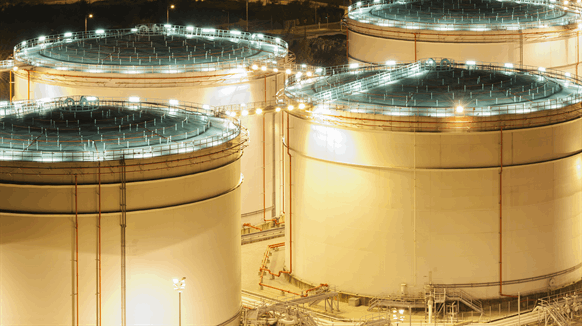China Oil Reserves Close to Capacity

(Bloomberg) -- China’s oil stockpiles have risen to around 100 days worth of net imports, making it increasingly challenging to find extra storage tanks and facilities to hold supplies, two people with knowledge of supply levels said.
The build-up follows a push by Beijing to buy up crude for its reserves last year when prices crashed due to the coronavirus pandemic. The figure represents government and commercial inventories, said the people who asked not to be identified because the information isn’t public. The reserves fluctuate but have consistently been at or above 100 days worth of imports and rose as high as 120 days recently, one of the people said.
Beijing set a goal of increasing government stockpiles to hold at least 90 days of net imports, Bloomberg reported in April last year. That target didn’t include commercial inventories. China’s National Energy Administration didn’t respond to a fax seeking comment.
As the world’s largest oil importer a sufficient level of reserves is critical for economic resilience to supply shocks such as a war in the Middle East. The International Energy Agency, which China isn’t part of, recommends that countries have enough crude to cover at least 90 days of net imports.
Unlike the U.S., where data about the nation’s strategic petroleum reserves are updated publicly and regularly, the size of China’s crude stockpiles are shrouded in mystery. There’s also less of a distinction between government reserves and commercial stockpiles, with many of the country’s biggest energy companies being state-owned.
China was moving forward with plans to buy up oil for its emergency reserves in April of last year, people familiar the plans said at the time. The initial target was to hold government stockpiles equivalent to 90 days of net imports, which could eventually be expanded to as much as 180 days when including commercial reserves, they said.
Last year’s crash in oil prices and China’s rapid rebound from the first wave of the Covid-19 pandemic set the stage for a flurry of crude purchases. However, stockpiling has leveled off as oil prices rebounded and storage space runs out, Capital Economics Ltd. said in a note this month. Fuel demand has also fallen this year amid a resurgence of the coronavirus in some parts of China.
Emergency reserves, including commercial storage, exceeded 100 days worth of net imports in the third quarter of last year, according to Yuntao Liu, a London-based analyst with Energy Aspects Ltd. “Going forward, as crude prices rise and plants launch seasonal maintenance from April, the need for re-stockpiling is not that urgent.”
China’s crude imports averaged 10.9 million barrels a day last year, according to import data compiled by Bloomberg, suggesting current stockpile levels of around 1.09 billion barrel. That aligns with an estimate from market intelligence firm Kayrros that the nation’s oil inventories rose to 1.01 billion barrels in the week through Feb. 14. Stockpiles reached a record of around 1.04 billion barrels in September last year, according to Kayrros.
--With assistance from Serene Cheong and Sarah Chen.
© 2021 Bloomberg L.P.
WHAT DO YOU THINK?
Generated by readers, the comments included herein do not reflect the views and opinions of Rigzone. All comments are subject to editorial review. Off-topic, inappropriate or insulting comments will be removed.
- Mexico Presidential Frontrunner Plans to Spend Billions on RE, Gas Power
- USA Regional Banks Dramatically Step Up Loans to Oil and Gas
- Venezuela Authorities Arrest Two Senior Energy Officials
- What's Next for Oil? Analysts Weigh In After Iran's Attack
- House to Vote on China's Iranian Oil Imports After Israel Attack
- Oil Markets Were Already Positioned for Iran Attack
- Germany to Provide $2.3B Aid for Decarbonization of Industrial Sectors
- Chile's ENAP Says Working on Decarbonization Plan
- An Already Bad Situation in the Red Sea Just Got Worse
- USA Regional Banks Dramatically Step Up Loans to Oil and Gas
- Valeura Makes Three Oil Discoveries Offshore Thailand
- Mexico Presidential Frontrunner Plans to Spend Billions on RE, Gas Power
- EU Offers $900MM in Funding for Energy Infrastructure Projects
- Macquarie Strategists Warn of Large Oil Price Correction
- JPMorgan CEO Says LNG Projects Delayed Mainly for Political Reasons
- USA, Venezuela Secretly Meet in Mexico as Oil Sanctions Deadline Nears
- EIA Ups Brent Oil Price Forecast for 2024 and 2025
- Petrobras Discovers Oil in Potiguar Basin
- EIR Says Oil Demand Will Not Peak Before 2030
- Biden Plans Sweeping Effort to Block Arctic Oil Drilling
- Pantheon Upgrades Kodiak Estimates to 1.2 Billion Barrels
- Dryad Flags Red Sea 'Electronic Warfare' Alert
- Russian Oil Is Once Again Trading Far Above the G-7 Price Cap Everywhere
- Oil and Gas Executives Predict WTI Oil Price
- New China Climate Chief Says Fossil Fuels Must Keep a Role
- Chinese Mega Company Makes Another Major Oilfield Discovery
- Oil and Gas Execs Reveal Where They See Henry Hub Price Heading
- Equinor Makes Discovery in North Sea
- ExxonMobil Racks Up Discoveries in Guyana Block Eyed by Chevron
- Macquarie Strategists Warn of Large Oil Price Correction
- DOI Announces Proposal for Second GOM Offshore Wind Auction
- Standard Chartered Reiterates $94 Brent Call
- Chevron, Hess Confident Embattled Merger Will Close Mid-2024


